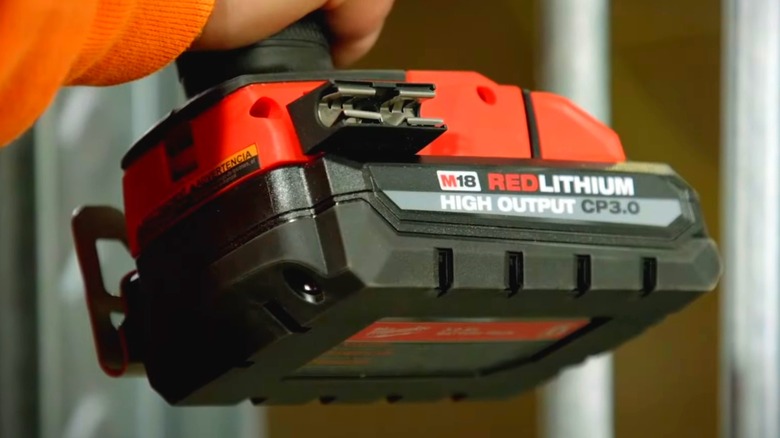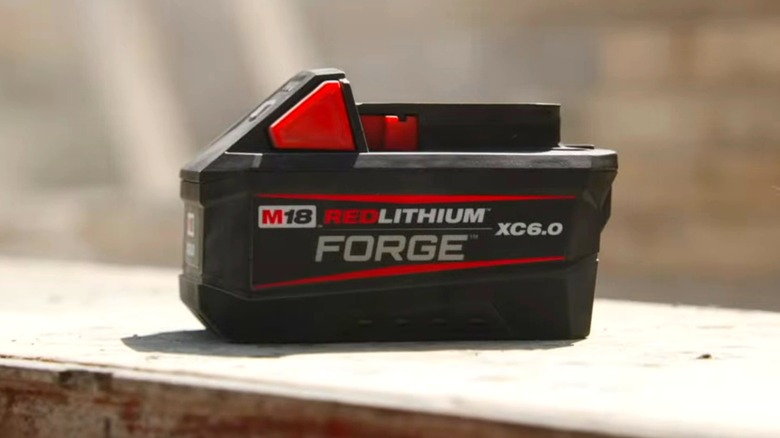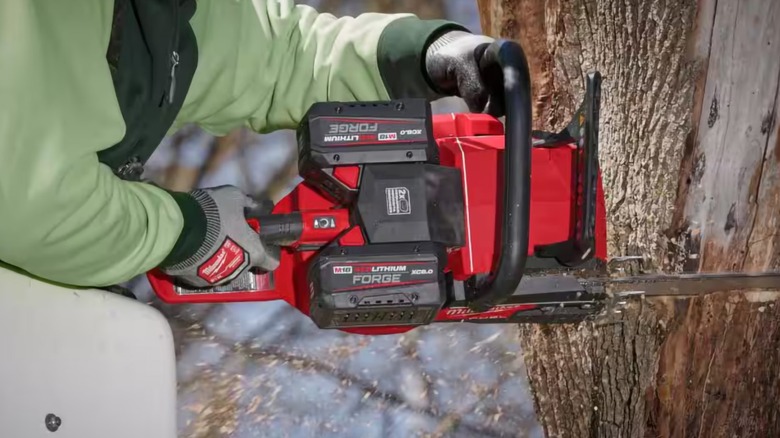Can Milwaukee Batteries Be Left In The Cold? Here's How Weather Affects Them
We may receive a commission on purchases made from links.
These days, if you're looking for high-quality power tools, most major brands won't have you confined to corded models. The bulk of the major power tool brands out there have very much embraced battery-powered tools, making their offerings more versatile and portable than ever before. However, with this innovation has come the need for users to be mindful of how their tool usage habits impact the health of their batteries. Even the likes of Milwaukee, known for high-quality, high-durability products, require that its batteries are taken care of properly to remain operational.
A major factor to consider when it comes to using, charging, and storing Milwaukee batteries is temperature. Can they be left out in the cold and still be usable? According to the Milwaukee website, Milwaukee REDLITHIUM batteries can be used in temperatures as low as -20 degrees Celsius or -4 degrees Fahrenheit. Thus, they can power your useful winter Milwaukee tools with little to no trouble. Before putting them to hard work in such frigid conditions or charging them up, though, it's best to give them time to warm up.
This involves attaching them to a tool and using it in a light application, a job that's not too demanding in terms of power but still gets battery energy flowing. Milwaukee's REDLITHIUM batteries are undoubtedly tough and can withstand some pretty low temps. At the same time, prolonged exposure to cold temperatures will likely impact their performance, like with any lithium-ion battery.
The cold impacts the efficiency of lithium-ion batteries
As great as lithium-ion batteries are for delivering power and longevity to their tools, they do have their limitations. For instance, the two ways of recycling lithium-ion batteries are expensive and complicated. Not to mention, their charge doesn't last forever, and they can have a hard time in lower temperatures. As mentioned, for Milwaukee REDLITHIUM batteries, -20 degrees Celsius or -4 degrees Fahrenheit is the low-end temperature threshold, with older battery brands unable to work in below-freezing temperatures.
After sitting in a cold environment for an extended period, the capacity of these batteries will decrease. This is because storing batteries in below-freezing temperatures can crack internal components, which diminishes electric storage. For the user, that means if you try to power your tools with these cold batteries, you're likely to get less time out of them before you have to put them on the charger. Unfortunately, charging in the cold can be a problem as well. Charging a lithium-ion battery in the cold could take longer than usual at best (low temps result in increased internal cell resistance, extending charge times) or damage the battery at worst.
Charging at or below 0 degrees Celsius or 32 degrees Fahrenheit is not recommended. Lithium-ion plating occurs at this point, and as a result, battery performance is severely reduced. Fortunately, you can prevent cold temperatures from harming your Milwaukee batteries. There are a few things you can do to ensure your batteries don't sustain damage in the cold of the winter months.
Protecting your Milwaukee batteries from the cold
Keeping Milwaukee batteries from being damaged by the cold is fairly straightforward. Be mindful of the environment you plan to use them in by checking the temperature, ensuring it's within the Milwaukee-recommended range. The same goes for battery storage, as Milwaukee has explained that storing batteries in a cool, dry place is the best way to go. If you plan on long-term storage, it's a good idea to keep your batteries somewhere that will stay in the same temperature range for the duration, like a climate-controlled garage, shed, or storage unit. You could even store them in your house. Temperatures should remain somewhere within the -10 to 50 degrees Celsius, or 14 to 122 degrees Fahrenheit.
There's also the matter of charging, which was previously stated as detrimental to your batteries below 0 degrees Celsius or 32 degrees Fahrenheit. You want to let the battery reach room temperature before placing it onto the charger and use an official Milwaukee model. Third-party chargers or those from other brands might not be of the same quality or may not be equipped for charging your batteries in the cold, so it's best to stick with a genuine charger just to be safe.
If you're particularly crafty, you can try making a Milwaukee warming box for your batteries, like the one showcased on the A Concord Carpenter / ToolBoxBuzz YouTube channel. This DIY project uses a Milwaukee Packout container as a base for climate-controlled storage for batteries, adhesives, and more. No one likes working out in the cold, not even lithium-ion batteries. So, it's important to take the necessary precautions to keep your Milwaukee batteries safe from the cold and the performance problems these frigid conditions can bring.


